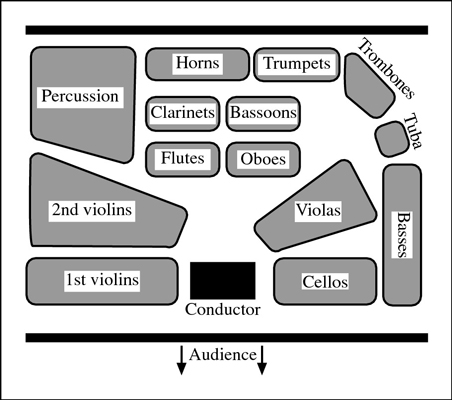If you like classical music and want to know more about it, start by learning the instruments of the orchestra; and discover a few important pieces of classical music, when they were each written, and in what style.
>
>
Getting to Know the Orchestra
It’s the big night and you take your seat in the concert hall ready to hear some classical music. You look up and see almost 100 people in the orchestra. Here’s a breakdown of the instruments they’re playing:
Violin: The instrument is made of wood; the bow is made of horsehair; the four strings are made of metal; the sound is sweet, singing, and divine. They’re divided into two sections, First and Second Violins, each with different music to play.
Viola: Slightly larger than a violin, playing slightly lower notes, with a breathier or throatier sound than a violin.
Cello: Played sitting down, with the instrument between the legs. Makes a beautiful, rich, singing sound.
Bass (or Double Bass): Enormous, bigger around than the average human being. Plays the lowest notes of all the strings, providing the foundation for the orchestra’s sound. Played sitting on a tall stool or standing up.
Flute: Blown across, just like a bottle; produces a sweet, silvery sound.
Oboe: Played by blowing into a reed, a whittled-down flat piece of sugar cane. Produces one of the most beautiful sounds on earth: clear, vibrant, sweet, plaintive, and full.
Clarinet: A dark, tubular woodwind instrument that creates a full, round sound, very pure, without the edge of the oboe’s sound.
Bassoon: Looks like a plumbing pipe; sounds like a dream. High notes sound throaty, even otherworldly. Middle notes sound luscious, full, mellow; low notes can be very powerful.
French Horn (or just Horn): The most noble-sounding brass instrument; has a full, round, dark tone, great for majestic hunting calls.
Trumpet: The most powerful orchestral instrument and the highest-pitched brass instrument. Executes impressive runs and leaps in a single bound.
Trombone: A powerful low brass instrument with a slide to change notes. Essential for parades, as well as symphonies.
Tuba: Lowest of the brass instruments. Can produce a wall of low, blasting sound.
Percussion: The player is expected to be a master of a vast range of different instruments: timpani (the great big kettledrums), bass drum, snare drum (for marches), cymbals (for crashing together), xylophone (played with mallets), and other oddities.

>
>
>
Timeline of Classical Music
It may surprise you to know that people are writing “new” classical music all the time. The following timeline shows you some of the most famous pieces of orchestral music along with basic guides to their stylistic periods (Baroque, Classical, Romantic, or Modern).

>
>
dummies
Source:http://www.dummies.com/how-to/content/classical-music-for-dummies-cheat-sheet.html
No comments:
Post a Comment